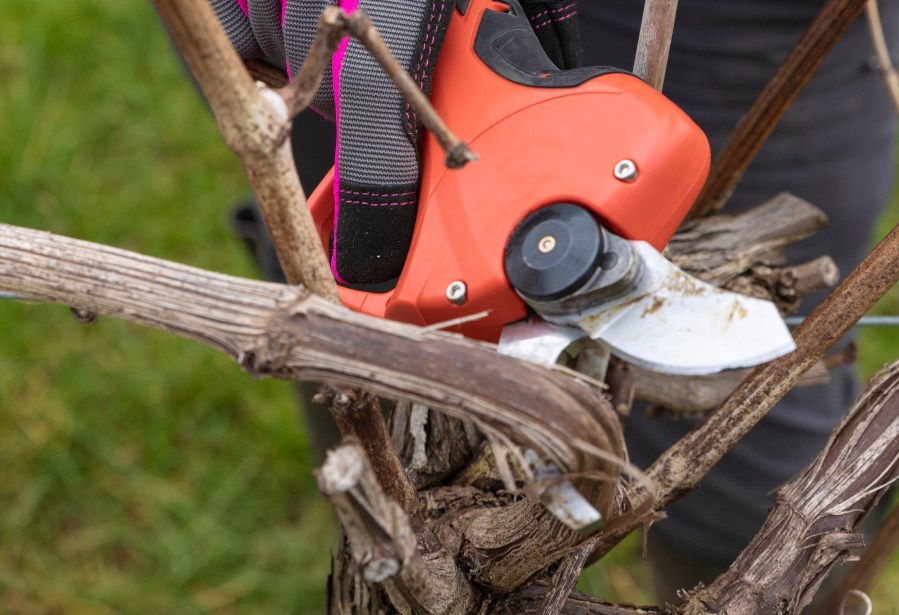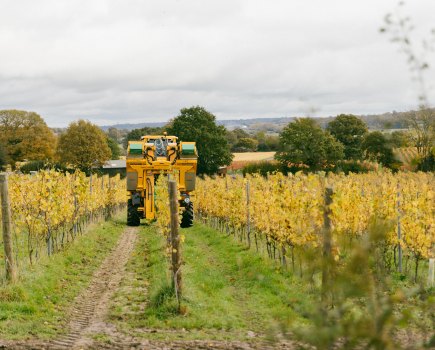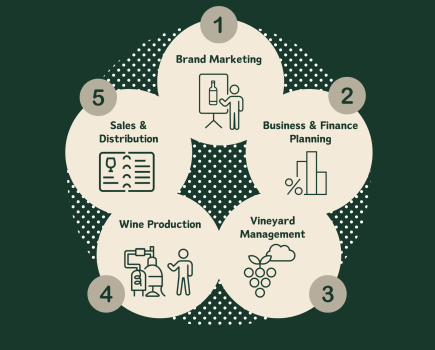I always say that pruning, that is winter pruning, is the only time of the year when you can really get your own back on the vine. It is the one time in the year when you have to address every vine on an individual basis, assess the state of its health, and make ‘life or death’ decisions about its future. This is also the time of the year of course when you assess each vine’s potential for cropping in the year to come, leaving the full compliment of buds that your trellising system and spacing allows, or leave a lighter load in the hope that it will recover some vigour to produce more fruiting wood in years to come. It is also the time of the year when you have to say, however reluctantly, that this vine’s days are numbered (or even over) and give the ultimate cut, right below the graft.
Winter pruning is also the time to look out for the signs of the many trunk diseases and viruses which affect vines. In reality this should be an ongoing process as some of the symptoms will first appear as discolourations on leaves or abnormalities of cane growth – short internode distances, bifurcation of canes, stunted canes or abnormal leaves. When you spot any of these, the vines need marking and noting so that their progress can be monitored.
The timing of pruning depends on many factors. How many vines have you got to prune? How many hands do you have to do the work? Are some of your vines on a site that often gets frosted and therefore might benefit from being pruned as late as possible? What training system are you using? Do you have machinery that might speed up the process i.e. powered secateurs or pre-pruning equipment?
Many larger vineyards will aim to make a start on pruning well before Christmas when the weather can often be kinder than in the first two months of the new year. Most growers will aim to get the pruning and pulling-out part of the three (or four depending on whether you count dealing with the prunings as a separate part of the pruning process) finished by the end of March, leaving tying down until the weather starts to warm up. However, I well remember going to a wine equipment show near Rheims in mid-November, and seeing a vineyard already completely pruned and tied down and prunings removed. I was told that the owner of that vineyard would regularly go away until March when he or she, needed to be back to start looking after the vines again. Like so many things to do with vineyards, a lot of what happens depends on the owner’s decisions.
The tools required for pruning haven’t essentially changed since it was discovered by the ancient Greeks (according to legend) that vines which donkeys had nibbled produced better grapes than those that were beyond nibbling donkey range. The first pruning aid was probably the curved pruning knife which the Romans called a falx vinitoria (and examples of which incidentally have never been discovered in Britain thus rather undermining the notion that Roman Britain was a country full of vineyards). Once some bright iron-age person had worked out that two opposing blades joined in the middle with a rivet i.e. scissors, could cut with greater ease and accuracy than a single blade, secateurs were invented which have not changed much since. Of course, many pruners prefer to use electric secateurs if, for nothing else, because they stop people getting RSI or other finger and hand-related injuries, plus they speed up the actual cutting process and allow for much larger cuts to be made cleanly and in exactly the right place.
The other pruning aid is the mechanical pre-pruner which can be attached to the front of a tractor and will slice through the canopy, miraculously missing the wires and retracting around the posts, reducing the previous year’s growth to nothing more than matchstick size pieces. In most spur-pruned vines, pre-pruners are commonly used as cordon-trained vines only needing short spurs for the next season. In cane pruned vines of course – and that covers over 90% of all English and Welsh vines – you need at least one full-length cane, and often two, of between 60cm and 1.00m long. Pre-pruners therefore can be used, but not as effectively as in spur-pruned vineyards, a factor that has limited their use in England and Wales. However, they do speed up the pruning process, especially the pulling-out part, so they are increasingly being seen, especially on the larger estates. The final parts of the pruning process, pulling-out, tying down and dealing with the unwanted prunings can be speeded up a bit with the right equipment, tying down guns and a decent prunings pulveriser. Burning prunings in situ in a chariot de feu is now no longer considered sustainable and banned under the SWGB scheme.
As was mentioned above, if you have a vineyard which gets frosted (in whole or in part), late pruning is one technique which is often cited as a way of delaying bud-burst and thus frost damage. Personally I think the beneficial effects of this technique are overstated as frost never works to a timetable and the timing of when bud-burst takes place is far more important. The best anti-frost technique that can be considered as part of the pruning process is to leave single or double sacrificial canes that can be retained if frost has robbed you of viable buds or removed if it has not.
After pruning has been completed and the growing season has started, the business of ‘canopy management’ in all its forms can begin. The term ‘canopy management’ was invented by two viticulturalists in New Zealand, Richard Smart and Mike Robinson, who co-authored a book called ‘Sunlight into Wine’ which was published in 1991. Receiving the OIV prize for books on viticulture, I don’t think it is too much to say that this book really brought home the importance of leaf quality, leaf exposure and how to prune, train and trellis vines for maximum photosynthesis.
In looking after vines, its always best to remember why we are growing them. In short, the answer is to produce carbohydrates, the more the merrier (subject to certain limits and depending on wine style) from which we can both produce alcohol and nourish the vine for the year to come. Everything done to a canopy should have this aim in mind.
I always say that we are actually farming leaves. Grapes and sugars are just a by-product. If this sounds outlandish, try stripping all the leaves off a vine and see what happens. The vine, being a perennial plant, also needs to be able to grow a cane (or canes) for the next season and this cane needs to be furnished with fruitful buds. Given that this cane is growing during the previous season to the one in which it is to be used, it stands to reason that a vine in poor health, a vine that is less than vigorous, a vine whose leaves are shaded and a vine whose leaves are rendered useless through attacks by disease or predators, will not perform as well as it might, resulting in grapes of lower quality and yields that are less than optimal both in the current year and future years.
To achieve optimum exposure in a vineyard canopy, several rules need to be followed. Don’t allow crowding or shading; remove what’s not needed especially around both the fruiting zone and next year’s canes. Older leaves (those nearer the previous year’s wood) once they have given up working in the sugar factory, and are just sitting in the canteen all day, can be removed. Plus of course, picking (by hand) from a canopy where the older leaves have been removed is up to 50% quicker than from one that has been left with its full complement of leaves.
Leaf-stripping in the fruiting zone in stages, has been shown to be the single most effective way of reducing disease in the canopy, especially Botrytis, which is most likely to appear as the grapes start to ripen and sugar levels rise and when most of the anti-botrytis sprays cannot be used because there is not enough harvest interval time. Leaf-stripping aids airflow, reduces shading, allows for quicker drying out after dew or rain, allows better penetration when spraying and exposure to UV light hardens the berries making them less susceptible to diseases.
Trials have shown that even total deleafing in the fruiting zone straight after flowering has no negative effects on yield, berry weight, cluster size or weight and that all the effects are beneficial. OK, so it’s a cost, but worth every penny. Hand leaf stripping of course is the simplest method and anyone can do it. However, it takes time and is expensive. Machines, single-sided or double sided, of different modes of operation (blow and slice, blow and shatter, suck and slice) all work differently and some vine varieties are much easier than others with certain machines. Its worth asking around to see if the densest variety you have responds better to one machine or another.
In summary therefore, canopy management is one of the most effective ways of getting maximum crops of ripe grapes, year after year. Remember it is better buds you need, not more buds. Better buds grow on shoots which receive their maximum dose of (free) air and light.
Next month I will be reviewing where we are in the vineyard with organic, biodynamic, sustainable, renewable, regenerative, permaculture, and (not forgetting) conventional viticulture. Is it all the emperor’s new clothes? Are the wines any better? Is it all worth it?
For more like this, sign up for the FREE Vineyard newsletter here and receive all the latest viticulture news, reviews and insight




